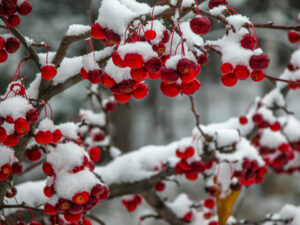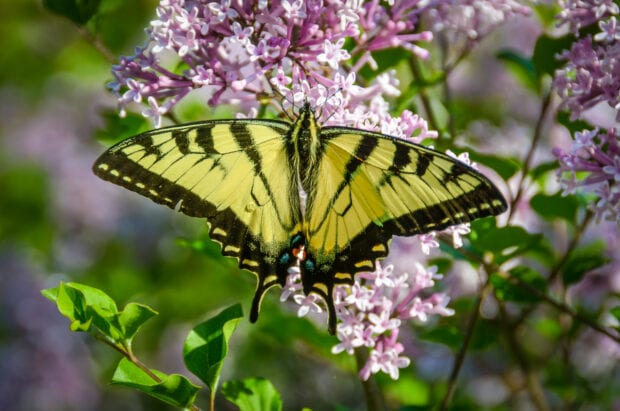Welcoming winged visitors to our gardens
We all love the flowers we grow in our gardens—an ever-changing palette from spring to fall—and by contrast, the stark beauty of winter.
But birds and butterflies add their own special and ephemeral magic to our gardens— they are like the icing on the cake. And, for me, the opportunity to observe these winged visitors as the seasons pass is an endless source of pleasure and wonder.
Highlights from my Goshen garden
This year the waning weeks of summer were pure delight, as butterflies and hummingbirds savored those last mellow days of the season.
Late summer and into fall

The last week of September: A Monarch with Painted Lady butterflies enjoys the nectar in the ‘Autumn Joy’ Sedum
It was early September as I watched a lone Monarch butterfly, surrounded by a consort of ‘Painted Ladies’, all feasting on a large patch of ‘Autumn Joy’ Sedum, while nearby half a dozen Monarchs fluttered above the tall stands of New York Ironweed and Joe Pye Weed. Meanwhile hummingbirds zipped all around, also seeking nectar from the late summer flowers.
By the third week of September—when the Fall Equinox signaled the official end of summer— the hummingbirds had already set out on their epic journeys to Central America. And by early October the final Monarchs had also departed on their own prodigious journeys to their wintering ground in central Mexico.
But then–much to my delight–some tortoiseshell butterflies discovered the fall asters and hardy chrysanthemums in the late autumn garden.
Fall is also when I love to watch the various sparrows and warblers as they forage on the ripening seeds of both grasses and perennials, including a huge stand of Purple Moor Grass and clumps of Heliopsis outside our bedroom window.
Wintertime

The fruit on the winterberries is like a magnet as the cedar waxwings make their final appearance of the season in the garden
In early November it is time for the cedar waxwings and robins to feast on the luscious fruit on the winterberries that edge the corner of our driveway. They then depart for the rest of the winter, returning only after the weather warms up in April or May.
But, around the middle of November (once it is consistently cold and I am convinced that the big bear, who lives up in the forest near here, should be hibernating) I will fill my winter bird feeders with sunflower seed.

The fruit on this crab apple variety ‘Snowdrift’ persists well into winter, creating a great food source for many birds– including the turkeys!
And, within five minutes, the first chickadees of the season arrive!! Chickadees will be regular visitors at our feeders all winter long, sometimes joined by house finch, siskin, goldfinch and the occasional grosbeaks.
Other birds come and go throughout the winter. Just this past December we watched in amazement as an emboldened flock of turkeys landed in the crabapple tree near the house and proceeded to devour the remaining fruit.
With the arrival of spring
Then, somewhere around the Spring Equinox the bird mix changes, as sparrows and other small birds return to the garden, scratching through the mulch beneath the shrubs in search of a succulent insect meal.
In early May I rehang the hummingbird feeders for the summer; this past spring it was May 7th when the first hummingbird arrived.
By the third week of May the garden becomes alive with Tiger Swallowtail butterflies—perfectly timed for them to feast on the emerging lilac flowers.
Soon they are joined by many others—including Painted Ladies, Monarchs, White Admirals, Mourning Cloaks—which all remain in the garden throughout the summer, visiting the many different flowers in search of nectar.
Raising families
And it is always fun to watch the nesting patterns of the various birds. For the past three years, a pair of catbirds has made use of the dense trio of Miss Kim Lilac shrubs outside our kitchen window as a safe spot to raise their brood. While all summer long a song sparrow—perching at the top of an evergreen—keeps watch over his growing family in a nearby group of spireas.
Meanwhile the acrobatic phoebes, who tuck their nests under the eaves of our barn, delighted us as they dart down and capture their insect prey in mid-air.
Every year, I watch in awe and delight as these and many other small miracles unfold before my eyes, all adding to the many pleasures I get from being a gardener.
Supporting birds and butterflies in our gardens
Beyond passively enjoying these winged visitors, I also strive to make my garden a truly hospitable habitat which I hope will encourage them not only to visit but also to stay awhile.
If we all do this, taken together our gardens can make a vital contribution to the larger environment. Today, as human development relentlessly expands—everything from housing and roads to farming—it fragments our wild places, making it harder and harder for all kinds of wildlife to find places where they can successfully reproduce and maintain their species. By creating a network of wildlife-friendly gardens, people can actively help these beautiful creatures propagate and flourish.
So, with that in mind, here are three ways we can transform our gardens into welcoming oases for birds and butterflies, as well as bees, which we love to see:
1: Grow native plants
Back in 2007, DouglasTallamy, professor of Entomology and Wildlife Ecology at the University of Delaware first published his landmark book ‘Bringing Nature Home,’ which was based primarily on his own extensive research.
In this eminently readable book he starts by describing how, for many birds, caterpillars and other insects form a major component in their diet.
In turn, the individual insect species, which of course includes butterflies, lay their eggs on very specific plants that their emerging caterpillars can eat. And, because insects evolve relatively slowly, most often these will be native plants that have been here for hundreds of years.
Hence, for many birds and butterflies, native plants form the bottom tier of the food chain. And growing a good mix in our gardens—including perennials, shrubs and trees— will indirectly contribute to the food supply of many kinds of butterflies and birds. His book provides extensive lists of plants that support different insects and birds.
2: Grow trees and shrubs that produce fruit or nuts

The native shrub, Wild Raisin (Viburnum nudum var. cassinoides), has charming creamy white flowers in June. The fruit gradually turns from red to dark blue, at which time the birds come to feast on it. which become fruits bird
Especially in the colder months, fruit and nuts are another important food source for many birds. And there are literally dozens of shrubs and trees that can flourish in Northeastern gardens which are also excellent food sources for birds.
To help you choose the best species of woody plants for your garden check out the excellent book: Trees, Shrubs and Vines for Attracting Birds’ by Richard M. DeGraaf, which provides a detailed description of over a hundred species, including many of my personal favorites such as serviceberries, crab apples, winterberries, mountain ash, and two native species of viburnum—the wild raisin and the American cranberry bush— as well as several kinds of roses.
Adopt wildlife-friendly gardening practices
Finally there are many simple things we can do to make our gardens more appealing to birds and butterflies, as well as. Here are six to consider:
Go organic
Go easy on the fall clean-up
Even in winter many flowering perennials and ornamental grasses are a source of viable seeds. By waiting until spring before we cut them back, their seeds will contribute to the food supply for birds that winter in our region.
And don’t be afraid to leave your garden a bit messy, especially in winter! Butterflies as well as other insects often overwinter in garden debris and dead leaves.
And, once the ground warms in springtime, you will see returning sparrows and other small birds scratching the soil in search of insects to eat.
Reduce your lawn
Lawns take both time and energy to mow and upkeep, while they contribute very little to the overall environment. So, if you have a large lawn, consider letting part of it revert to meadow. Mow this area just once or twice a season; in a year or two it will be full of beneficial wild flowers and grasses.
And for the lawn you do mow regularly—raise your mower blade to 3 inches or higher. Not only will this result in healthier greener grass, but your lawn will also support small insects and worms that too contribute to the food chain.
Creating cover
Birds need safe cover, both for nesting and to avoid predators. When planting shrubs, rather than dotting them around singly, mass them together in irregular groups of three or five.
We often hear about the need to support the many kinds of pollinators— especially the different species of wild bees that in many cases are nearing extinction. As they visit our flowers bees and butterflies (as well as hummingbirds) are looking for nectar, but in so doing they also distribute pollen to adjacent flowers. Thus planting flowers identified as ‘pollinator-friendly’ will bring both bees and butterflies to your garden. Check the informative website of UVM’s Jane Sorenson at http://www.riverberryfarm.com/pollinator-plants-at-river-berry-farm/ for charts of pollinator-friendly garden flowers by height, color and bloom-time.
Plant it and they will come
Fall is a wonderful time not only to make plans for the future gardens, but also to get digging, divide and move perennials and even buy new plants.
So, if creating a garden oasis for winged visitors is on your wish list, this is the perfect time to start.
And, if you live in a communal setting with common land, why not get together with your neighbors to create a neighborhood garden that both people as well as butterflies and birds will enjoy

